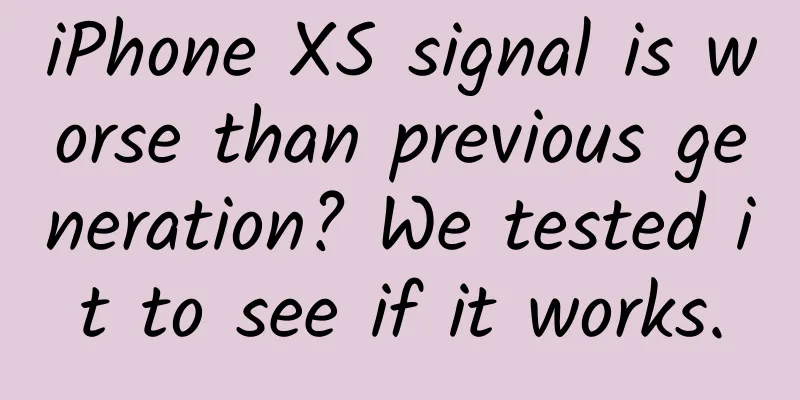iPhone XS signal is worse than previous generation? We tested it to see if it works.

|
With the iPhone XS series going on sale last week, many users have received their long-awaited new phones. However, the launch of this new phone seems to be not going smoothly. Less than a week after it went on sale, problems such as poor call quality and signal drops have been frequently exposed among users around the world. Since it is a signal reception problem, the Intel baseband used in the iPhone XS has naturally become the main suspect affecting signal reception, and online public opinion has also pointed to the baseband as the culprit of these problems. So, is the signal of iPhone XS really worse than its predecessor? Why did Apple abandon Qualcomm and bet on Intel? Today we will test it through several scenarios. Who is weak and who is strong? Pull it out and you will know According to the iPhone XS series disassembly report released by iFixit earlier this week, Intel provided Apple with two modem chips, the 9955 J825YD05 10PSV (XS) and the 9955 X816YD5R P10PHV (XS Max), which are also known as Intel's latest full-network baseband XMM 7560. iPhone XS motherboard, the orange part is the baseband chip. Image from: iFixit Through the AIDA64 program, we can find out that the Chinese version of iPhone 8 Plus and iPhone X both use Qualcomm MDM9655 chip. Left: iPhone 8 Plus, Right: iPhone X (both Chinese versions) Unfortunately, AIDA64 does not support iPhone XS Max yet, and it shows multiple items as Unknown during testing. Therefore, with the help of another software CPU-Z, we finally confirmed that the Chinese version of iPhone XS Max in our hands uses the baseband solution (Intel XMM) supplied by Intel, which is the XMM 7560 mentioned in the iFixit disassembly report. Since the previous generations of iOS systems, users can use the Field Test mode to view real-time signal values in the signal bar. However, Apple has cancelled the dBm display of Field Test in the system signal area after iOS 11, and iPhones using Qualcomm baseband after this version cannot display signal dBm in Field Test. So in this test, we used iPhone XS Max and Samsung Galaxy Note9 (Qualcomm Snapdragon 845 processor) on the same carrier and in the same test environment to compare the signal and network speed, and then added iPhone X for network speed comparison. Since the test results vary from place to place, the results are for reference only (the larger the dBm value, the stronger the signal). On the roadside Left: iPhone XS Max (RSRP), Right: Galaxy Note9 (signal strength) Walking on the street, we took out two mobile phones for comparison. Under the same operator and without protective cases, the dBm value of iPhone XS Max was -76, and the dBm value of Note9 was -70. In a crowded shopping mall Left: iPhone XS Max (RSRP), Right: Galaxy Note9 (signal strength) Then we went to a shopping mall near the company to test it indoors. At this time, the dBm of iPhone XS Max was -83, and the dBm of Note9 was -76. The signal dropped by one bar, but the Qualcomm baseband was still slightly better. iPhone XS Max, iPhone X, Galaxy Note9 speed test In the Speed Test, we can see the difference between the two phones in network transmission. In the same environment, the download speed of Note9 soared to 5013KB/s, and the upload speed reached 843KB/s. In contrast, the iPhone XS Max is slower, but also slightly faster than the iPhone X, reaching 4161KB/s for download and 817KB/s for upload. Fire Stairs Left: iPhone XS Max (RSRP), Right: Galaxy Note9 (signal strength) Walking to the back staircase of the mall, the signals of the two phones increased instead of decreased, but the Snapdragon 845 baseband was still slightly better. The dBm of the iPhone XS Max was -77, and the Note9 was -70. We walked down the back staircase to the underground parking lot. iPhone XS Max, iPhone X, Galaxy Note9 speed test In terms of network speed performance, Qualcomm is still in a crushing state, reaching 9731KB/s download and 973KB/s upload. iPhone XS Max also reached 7737KB/s, and the upload speed was the same as Note9, also 973KB/s. Underground parking lot Left: iPhone XS Max (RSRP), Right: Galaxy Note9 (signal strength) The underground parking lot is on the negative third floor, and the signals of both phones dropped immediately, and there was a slight gap. The dBm of iPhone XS Max dropped to -113 at this time. Although it was on 4G, web page reading was obviously slower. The dBm value of Note9 fluctuated between -100 and -105, which was not stable but still slightly stronger than iPhone XS Max. Through the comparison of the above scenes, we can also clearly understand the difference between XMM 7560 and Qualcomm X20 LTE. Why choose Intel? Apple has fully chosen Intel instead of Qualcomm, its long-time partner, for its new iPhone. There are rumors online that Apple did this to save costs, or that Qualcomm and Apple had an unhappy collaboration, but in the final analysis, the main reason is Qualcomm's accusations against Apple last year. In the documents Qualcomm submitted last November, they stated that during Apple's previous cooperation with Qualcomm, it used the technology provided by Qualcomm to improve Intel's modem chips (baseband), thereby helping Intel, a competitor of Qualcomm, solve the problem of poor performance. As early as June last year, Qualcomm and Apple went to court over patent technology issues. The updated allegations further supplemented the evidence that Apple stole trade secrets and deceived its partners. Qualcomm stated in its accusation document that Apple not only improved its own chip performance through Qualcomm's technology, but also helped Intel improve its baseband components. Therefore, in the context of the confrontation between Qualcomm and Apple, this year's iPhone XS series all use baseband chips supplied by Intel, rather than Qualcomm, which has cooperated with Apple for many years. However, in the face of Qualcomm's accusations, neither Apple nor Intel has yet made an official response. Will Intel, which has been catching up, be the leader in new phones next year? Intel has never let me down, except when it comes to baseband. As mentioned earlier, Qualcomm and Intel are both baseband chip suppliers for the iPhone. In fact, the iPhone XS series is not the only Apple model to use Intel baseband chips. Image via: YouTube Apple used Infineon's baseband chips in its early iPhones. After Intel spent $1.4 billion to acquire Infineon in 2010, Intel officially became a chip manufacturer competing with Qualcomm. However, as the world was preparing to enter the 4G communication era at that time, Apple began to adopt a small number of dual-baseband routes. Most iPhones used basebands supplied by Qualcomm, while a small number of iPhones used baseband chips supplied by Intel. Until the iPhone 4s era. Before the iPhone 7, Qualcomm was the main supplier of iPhone baseband chips. But later, Intel also joined the iPhone baseband array, so we can also see Intel XMM-labeled basebands on the iPhone 8 and iPhone X. According to some Weibo users, the Chinese version of the three-network iPhone 8/X uses Qualcomm's MDM9655 chip, while some dual-network versions use Intel's XMM 7480. Although both basebands are the best chips of Qualcomm and Intel, there is still a gap between the two. From the iPhone X dual-core test results given by Cellular Inights, Qualcomm's baseband is better than Intel's in terms of download speed and network signal. Although the gap is not obvious, there is still a distance between the two. However, although the difference is not big, it will naturally make consumers feel unfair: How can I buy a phone with worse signal for the same price? From Qualcomm's accusations against Apple, Qualcomm once pointed out that Apple did not fully utilize the performance of Qualcomm baseband chips in iPhone 7, indirectly covering up the network performance differences between Qualcomm and other manufacturers on iPhone devices. In other words, Apple is taking special care of Intel. If performance adjustment is Apple's special care for Intel, then the dispute with Qualcomm, the launch of XMM 7560, and the lower price are the main reasons why iPhone XS fully adopts Intel baseband this year. Apple's choice of Qualcomm can be seen as a disguised compromise to full network access. After all, support for CDMA is still a hurdle for Intel baseband, which is why we could only see Intel baseband on non-national iPhones before. But with the launch of the full network access baseband XMM 7560, Intel has solved the problem of network support, and the technology has gradually matured. Therefore, while Qualcomm challenged Apple, Intel offered a lower price than Qualcomm, so the new baseband was also adopted by Apple in large quantities. There is no harm without comparison. Judging from several actual test results of XMM 7560, although this chip has solved the CDMA support problem of Intel baseband, it has also improved the level of network transmission. But in fact, it is still a distance away from Qualcomm's X20 baseband. The gap has narrowed, but it has not yet been surpassed. Image from: Cultofmac However, from the overall situation of Apple betting on Intel and daring to challenge Qualcomm this year, we can easily observe several pieces of information: First, Intel offered a relatively favorable price to allow Apple to equip new mobile phones in large quantities; second, Intel's baseband technology has matured and has been recognized by Apple, and it may continue to purchase in large quantities in the future; if Intel can serve as Apple's long-term backing, then the dispute between Qualcomm and Apple will not be settled in the short term. In addition, it can be speculated that if the dispute between Qualcomm and Apple continues until 2019, next year's iPhone may continue to use the baseband supplied by Intel. |
<<: A deep dive into iOS 12's new features: A guide to Shortcuts
>>: Everything you need to know about Binder as an application developer
Recommend
Top 10 PR Creative Communications in 2019
Public relations requires more creativity. I have...
Siri may be able to answer calls for you and convert them into text messages
[[143765]] If you have always regarded Siri as a ...
Best Practices for Agile Data Operations in Internet Finance—Wang Tong
Wang Tong , Vice President of Sales at Beijing Yo...
World's first! Surgical robot autonomously performs laparoscopic surgery in pigs
Written by: XT Editor: Kou Jianchao Layout: Li Xu...
How to write a good event promotion plan?
How to write a publicity plan? Why has my plan no...
Analysis of Xiaomi’s advertising and marketing!
Xiaomi has struck a very delicate balance between...
Douyin has more than 150 million daily active users, but the war between short video platforms continues
Yesterday afternoon, Douyin short video announced...
With limited resources, how can entrepreneurs make a good App?
[[153097]] Today, the cost of acquiring users for...
The Secrets of Google's Nexus Codenames
Just as Android versions are named after desserts...
Vice President of Product at Lizhi FM: Sharing of experience in operating UGC products
A UGC platform is an ecosystem. To develop sustai...
Do animals know numbers? What are their mathematical abilities?
Number recognition is a basic skill for humans. I...
When “miracle drug” turns into “poison”: What are the health traps behind glucocorticoids?
Tuchong Creative In the World Health Organization...
Deconstructing private domain traffic: How to manage personal IP?
Personal IP refers to an individual’s right to ow...
Hupu APP Product Analysis Report
This article conducts product experience and anal...









